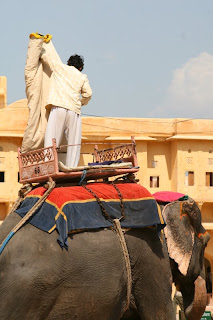
McCleod hill station

Himalaya foothills
We spent a couple of days hiking around the hills and visiting the local lakes and waterfalls.
In addition to the climate change the Tibetan-Buddhist-influenced culture of the area was a welcome change as well.
 McCleod it turns out, or more specifically, Dharamsala, about 4km south, is the home of the Dalai Lama, the Tibetan government, and about 400,000 other Tibetans in exile.
McCleod it turns out, or more specifically, Dharamsala, about 4km south, is the home of the Dalai Lama, the Tibetan government, and about 400,000 other Tibetans in exile.

Buddhist monks in front of Dalai Lama residence
It was neat to see a new culture. There was a large Buddhist temple in town where many young and old monks and other Buddhist pilgrims would circle and spin the mani prayer wheels (Om Mani Padme Hum) elevating their karma.

Buddhist stuppa

young and old monks
 One night a crowd gathered in the streets with candles and flags for a a Free Tibet rally.
One night a crowd gathered in the streets with candles and flags for a a Free Tibet rally. Helen and I had seen 'Free Tibet' stickers before..usually stuck to the bumpers of dilapidated old VW's. We had a vague knowledge of the Chinese occupation of Tibet and that the Dalai Lama was living in exile. The day after the rally we read a bit about the history of Tibet and attended a showing of a documentary film about the crisis in Tibet and the plight of the refugees. Until arriving in McCleod though I don't think we had a real sense of magnitude of the situation. Without getting too deep it seems that in 1950 the Chinese Maoist decided to invade and 'liberate' Tibet and have since then engaged in a systematic destruction of the Tibetan culture, a sort of culture-icide if you will, forcing Tibetans to adopt Chinese language and customs and cannibalizing all Tibetan cultural and historical relics. In an attempt to preserve their cultural heritage and historical identity many Tibetan, led by the Dalai Lama, have fled Tibet into India and Nepal to established refugee communities where children can grow up and live free as Tibetans.
Helen and I had seen 'Free Tibet' stickers before..usually stuck to the bumpers of dilapidated old VW's. We had a vague knowledge of the Chinese occupation of Tibet and that the Dalai Lama was living in exile. The day after the rally we read a bit about the history of Tibet and attended a showing of a documentary film about the crisis in Tibet and the plight of the refugees. Until arriving in McCleod though I don't think we had a real sense of magnitude of the situation. Without getting too deep it seems that in 1950 the Chinese Maoist decided to invade and 'liberate' Tibet and have since then engaged in a systematic destruction of the Tibetan culture, a sort of culture-icide if you will, forcing Tibetans to adopt Chinese language and customs and cannibalizing all Tibetan cultural and historical relics. In an attempt to preserve their cultural heritage and historical identity many Tibetan, led by the Dalai Lama, have fled Tibet into India and Nepal to established refugee communities where children can grow up and live free as Tibetans.
This need to preserve a free Tibetan way of life is so strong that many parents send their children over the hill (i.e. the Himalaya's) knowing that they may never see them again. And this is what the documentary film was about. The film followed several young Tibetan children sent away from their homes in Tibet and their perilous journey over the Himalaya's into India. What was particularly moving about the film is that it featured many of the locals from the area, several of whom were sitting in the audience. So when you watch the guide taking these 8 year old kids through shoulder high snow drifts, fighting off frostbite and snow blindness, and running and hiding from the Chinese authorities at the Nepalese border and then you look over and sitting there is the guide with one of the kids (now 15) you couldn't help but feel moved by the reality of the situation. Especially when you learn that not all of the kids make it..some are lost to the elements..others are captured and imprisoned for years (the guide in the movie/audience was only recently released from spending 2 yrs in a Chinese prison)..still others are shot and killed by Chinese authorities, the most recent case of this was a shooting that occurred last month, claiming 9 people. To complicate matters more, Nepal has apparently recently changed its stance on Tibet and is now cooperating with China to capture and return refugees. The future looks bleak for Tibet it seems...
Anyway...
While shopping we came across a necklace for our friend Pierre.. (you know you love it P)

Some other monk pics..






















































